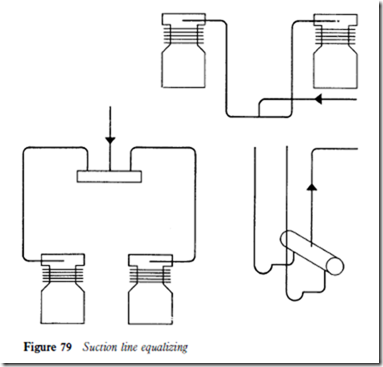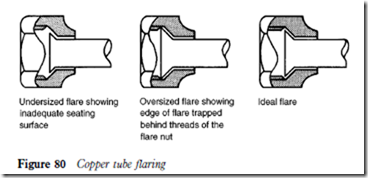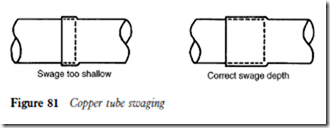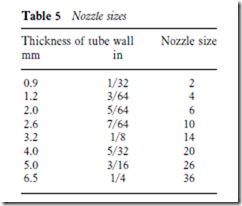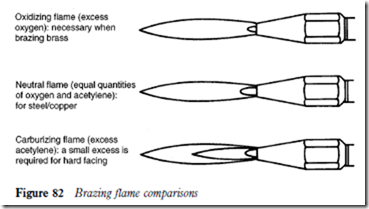Suction line equalizing
Pipework should be routed to a manifold arrangement to equalize pressure at each unit. Common suction lines will drain freely, so this method is suitable for most systems (Figure 79).
When the evaporator is at a lower level than the compressor, the suction line should be pitched downwards. There should be two oil traps approximately 0.5 m (20 in) in height when suction risers are in excess of 3 m (10 ft).
Pipework assembly
Soft copper tubing up to 22 mm (7/8 in) diameter may be joined with flare fittings or by brazing. Hard drawn copper tubing is brazed. Iron and steel pipework is welded; cost restricts the use of welding to large industrial and ammonia systems, and it is not described here.
lare fittings
Flare connections will be perfectly satisfactory if the flaring of the tubing is carried out correctly.
Undersized or oversized flares are potential sources of leaks. In an under- sized flare the flare seat surface area is reduced and can allow movement within the flare fitting if the pipework is subjected to excessive vibration; the joint will eventually fracture. An oversized flare may prevent the correct seating to a union or a control; although it may well pass a leak test, a leak may develop when the pressures within the systems rise during operation. Flares are shown in Figure 80.
A good flare should allow withdrawal of the flare nut over the threads after it has been tightened down on to a union.
Brazing
Currently, most copper tubing is assembled with brazed joints because it is cheaper. In addition, if joints are made correctly the possibility of leaks is reduced.
Expanding
In order to make a brazed joint the tubing has to be expanded. Various tools are available for this purpose: the punch-type expanders, swage formers used with a flare block and spinner, and the more elaborate tube expander.
The tube expander is generally used for larger diameter tubing, which may be hard or soft drawn copper. Hard drawn copper must be annealed before attempting to expand the tube. Annealing is a softening process, involving heating the tube and allowing it to cool.
When using a swage former or the expander, the depth of the swage will be determined by the former. It is approximately equivalent to the outside diameter of the tubing. Too shallow an expansion of the tube tends to produce a weak joint (see Figure 81).
Process
Brazing can be defined as jointing by applying high intensity heat to a high melting point alloy in order to fuse together two metal surfaces. It is often referred to as silver soldering.
Brazing rods should be cadmium free, and as described in BS 1845. All brazing should meet the requirements of BS 1723.
Hazards
Whilst it is possible to prefabricate some parts of the system pipework assembly in workshops, most brazing will be carried out on site.
The operator must be conversant with the site safety regulations and comply with fire regulations. Attention must be paid in particular to fire and smoke alarms whilst the brazing operations are being performed.
Where possible, work away from flammable materials such as wooden floors, joists and eaves. Use a protective metal or fire resistant sheet under conditions where a fire risk is obvious. Keep a fire extinguisher to hand when working in a risk area.
The number of brazed joints should be kept to a minimum, and the bending of copper tubing is preferred.
Preparation
All pipework and fittings to be brazed must be cleaned to remove dirt and oxides using a fine grade steel wool. A solvent may be necessary to remove preservative coatings from components or fittings.
Heat shields should always be used to protect areas surrounding the joint and to concentrate heat. Protect the system components, which could suffer damage when heat is applied, by wrapping a damp cloth around the compo- nent close to the joint.
Ensure that all joints are a tight fit. Support the pipework before brazing is attempted; any movement before the alloy has set can result in a leak or a weak joint.
Equipment usage
Select the correct pressure and nozzle (Table 5). Always light the blowtorch with a spark gun and not with matches or a cigarette lighter. Adjust the blowtorch to give the correct type of flame (see Figure 82).
Wear protective clothing and tinted goggles or glasses. Keep oxygen and acetylene cylinders away from any heat source. Always close down the equipment valves when leaving it unattended, even for a short period. Do not smoke when brazing. Note that toxic atmospheres are created during brazing operations when cadmium, galvanized metal and paint are heated.
Always pass nitrogen through the pipework or component being brazed to prevent oxidation and the formation of scale on the interior surfaces. Clean off all joints after brazing, especially when a flux has been used.
When brazing copper tubing, the joint area should be heated broadly with a continuous circular movement of the blowtorch until the copper changes colour to a cherry red; then apply the brazing rod. This will minimize the risk of local overheating and burnt tubing. Heat should be applied indirectly so that the rod and flux are melted by conduction through the base metal.
